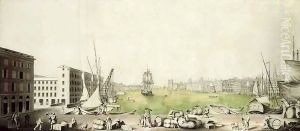Louis Amphoux Paintings
Louis Amphoux was a French artist born in 1751 in Aix-en-Provence, France. Although not widely recognized in the mainstream art historical canon, Amphoux was known for his contributions to the world of miniature painting, a form of art that gained significant popularity in the 18th century, particularly in France.
Amphoux's early life is not extensively documented, but it is known that he was active during a time when miniature painting was transitioning from being a personal, intimate form of art to a more commercial one, with artists producing miniatures for a growing middle-class clientele. This period was marked by the influence of the Rococo style, characterized by elaborate ornamentation and a light, graceful approach to art.
Throughout his career, Amphoux developed a meticulous painting technique, often working on ivory, a preferred medium for miniature painters due to its smooth surface and the luminous effect it could impart to the painting. His works were typically small, delicate portraits, intended to be kept as mementos or tokens of affection, reflecting the sentimental value attached to miniatures during the era.
The French Revolution and the subsequent Napoleonic Wars brought significant upheaval to France, which affected the art market and the demand for luxury items like miniature portraits. Despite this, Amphoux continued to create his art, though like many of his contemporaries, he may have adapted his subject matter or style in response to the changing times.
Louis Amphoux passed away in 1828. While he may not have achieved the same level of fame as some of his peers, his contributions to the art of miniature painting represent an important facet of French art during the late 18th and early 19th centuries. His works, along with those of other miniaturists of his time, help to provide a fuller picture of the artistic tastes and social customs of his era.
